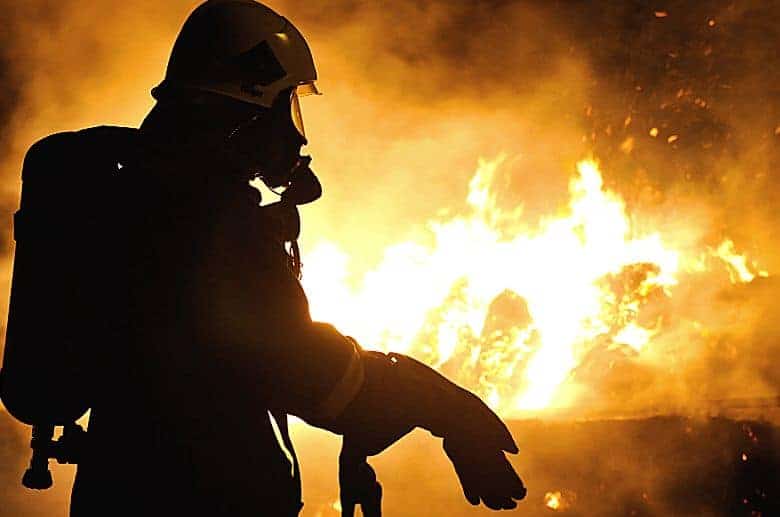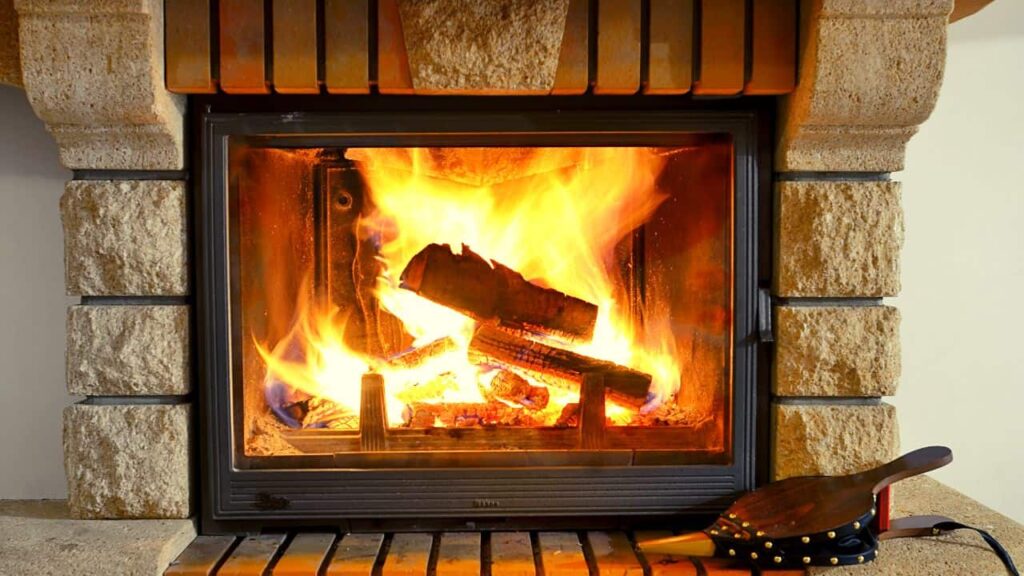Creosote buildup is one of the most common problems homeowners face with wood-burning fireplaces. Creosote is a natural by-product of burning wood, and it can be very difficult to remove. If left unchecked, creosote can eventually lead to a dangerous chimney fire.
While a small amount of creosote buildup is normal, a large buildup can cause concern. That’s why it’s important to have your chimney inspected and cleaned regularly.
But what is normal creosote buildup? And how can you tell if you have a problem?
In this guide, we’ll answer those questions and more. We’ll also give you some tips on preventing creosote buildup in the first place.
What is considered normal creosote buildup?
Creosote exists in three stages that we’ll look at later, but for now, let’s focus on the first stage of creosote: light soot.
All wood-burning fireplaces produce light soot that clings to the glass doors, hearth, and walls near the fireplace. While normal and expected, this buildup can be unsightly.
Therefore, the first stage of creosote is the one considered normal. This stage is nothing to worry about and can be cleaned with normal products. Just remember to do it regularly to avoid the second stage of creosote.
How to know if you have normal creosote buildup?

There are a few key things to look for when trying to determine if you have normal creosote buildup:
1. Dark smoke from your chimney
Externally, your chimney will have normal soot on the outside that you can easily clean. However, if you see darker smoke coming from your chimney, this could signify more creosote starting to form.
2. Ash on the hearth
Another sign of normal creosote buildup is ash on the hearth near your fireplace. This is because wood-burning fireplaces produce light soot that you can easily clean up with a vacuum.
3. Soot in and around your fireplace
If you see soot in and around your fireplace, this is normal. This happens because wood-burning fireplaces don’t have full combustion, which means that some of the carbon in the wood doesn’t burn.
The unburned carbon condenses on the surfaces inside your fireplace and chimney as a black substance called soot.
4. Stains on your fireplace doors
Finally, if you see black and deep brown stains on your fireplace doors, this is also a sign of normal creosote buildup. You can clean these stains with a glass cleaner and a soft cloth.
In conclusion, normal creosote buildup is nothing to worry about and can be easily cleaned. Just remember to do it regularly to avoid the second stage of creosote.
If you aren’t familiar with the process, the best way to clean it is by hiring a professional chimney sweep service.
——
Do You Need to Hire Chimney & Fireplace Expert?
Get free quotes from qualified experts near you. No commitment required!
——
Where does creosote buildup the most?
Creosote buildup can happen anywhere in your fireplace or chimney, but it usually builds up the most on the hottest surfaces. This includes the firebox, the damper, and the smoke chamber.
When this happens, it’s important to clean the affected areas as soon as possible to prevent the buildup from progressing to the second stage. The best way to do this is to hire a professional chimney sweeper to come and do it for you.
Chimney sweep professionals have the proper equipment to do the job, and they’ll also be able to spot any other potential problems with your fireplace or chimney.
What does creosote buildup in chimney look like (Stages of creosote)
As promised earlier, here are the three stages of creosote:
Stage 1 creosote buildup
Stage 1 creosote buildup is flaky and powdery, similar in appearance to ashes. This is the least dangerous stage of creosote buildup, but it’s still important to regularly remove it from your chimney.
Stage 2 creosote buildup
The second stage of creosote buildup is characterized by a black or brown substance that is flaky, crusty, and hard. Normal creosote buildup occurs when the temperature in your chimney is between 250 and 450 degrees Fahrenheit.
When the temperature gets hot enough, the gases released from burning wood condense on the cold surfaces of your chimney, resulting in normal creosote buildup.
If you have normal creosote buildup in your chimney, it is important to remove it regularly. Normal creosote can turn into Stage 3 creosote, which is much more dangerous if left unchecked.
Stage 3 creosote buidup
This is the last and most dangerous stage of creosote buildup. It resembles a high concentration of thick tar and is highly flammable. This level of buildup significantly increases your risk of a chimney fire.
At this point, the creosote is flammable and can easily ignite, leading to a chimney fire. You’ll need to hire a professional to remove the creosote before it gets to this point.
What are the risks of creosote buildup in the flue?
As explained earlier, normal creosote buildup is not dangerous and can be cleaned by a professional. However, if the creosote reaches Stage 2 or 3, it becomes a serious fire hazard.
Here are some of the risks of ignoring creosote buildup in your flue:
Fire hazard

The possibility of a chimney fire is the most serious risk of creosote buildup. As the creosote becomes thicker and more concentrated, it becomes increasingly flammable. Even small sparks from your fire can ignite the creosote and cause a dangerous chimney fire.
Damage to your home
Chimney fires can spread to the rest of your home, causing extensive damage. In some cases, the fire can even cause the collapse of your chimney.
This means more repair costs and possibly even temporary displacement from your home while the repairs are being made.
Carbon monoxide poisoning
The creosote can release toxic fumes into your home as the fire burns, leading to carbon monoxide poisoning. This is especially dangerous if you have a gas-powered heater or stove.
The symptoms of carbon monoxide poisoning include headaches, dizziness, nausea, and confusion. If you experience any of these symptoms, you should immediately get fresh air and call 911 or an ambulance for medical help.
Damage to your health
Besides starting a fire or blocking the airflow in your flue, creosote buildup can also damage your health in other ways.
The fumes from the creosote can be harmful if inhaled, and the dust can cause respiratory problems. Researchers found that the fumes can lead to cancer in severe cases.
That’s not all. If you touch the creosote, it can cause skin irritation. So it’s important to be careful when cleaning your chimney or removing the buildup yourself.
It’s always best to hire a professional to do the job. They have the training and experience to remove the creosote without putting themselves safely or your home at risk.
——
Do You Need to Hire Chimney & Fireplace Expert?
Get free quotes from qualified experts near you. No commitment required!
——
How to prevent creosote buildup?
Preventing creosote buildup in your flue is best to protect your home from a fire. Here are some tips on how to do that:
Burn dry, well-seasoned wood
Wet or unseasoned wood releases more water vapor and gases as it burns. This increases the chances of condensation and creosote buildup.
Instead, burn dry, well-seasoned wood. Seasoned wood is less likely to cause creosote buildup because it has been properly dried and has less moisture content.
Use a fireproof log
A fireproof log is a specially treated log that produces fewer flames and sparks when burned. This can help reduce the amount of creosote that builds up in your chimney.
Don’t build a big fire
Bigger fires produce more smoke and flames. This can lead to more condensation and creosote buildup.
Instead, build smaller fires that burn slowly and evenly. This will produce less smoke and help prevent creosote buildup.
Don’t overload your fireplace

Overloading your fireplace with too much wood can cause the fire to smolder. This produces more smoke and increases the chances of creosote buildup.
Instead, build smaller fires and add wood as needed to keep the fire burning evenly.
Don’t use your fireplace as a trash can
Burning garbage in your fireplace is a bad idea for many reasons. It produces harmful chemicals and toxins that can damage your health. It also creates more smoke and soot, leading to creosote buildup.
Don’t use chemicals to remove the creosote
Many products on the market claim to remove creosote from your chimney. But most of these products are ineffective and can be dangerous.
Some of these products are flammable and can increase the fire risk. Others release harmful toxins and chemicals into the air. So it’s best to avoid them altogether.
Use creosote logs
Creosote logs are logs that have been treated with chemicals that help to prevent creosote buildup. They can help prevent creosote buildup, but they should not be used as a substitute for professional chimney cleaning.
Schedule annual chimney inspections
It’s important to have your chimney inspected by a professional at least once a year. They will be able to identify any problems and make sure your chimney is clean and safe.
Conclusion
Normal creosote buildup is a normal occurrence when burning wood in your fireplace. But if not removed, it can be dangerous. It can cause a fire or block the airflow in your flue. It can also damage your health if you inhale the fumes or come into contact with the dust.
The best way to prevent creosote buildup is to burn dry, well-seasoned wood. You should also use a fireproof log and build smaller fires that burn slowly and evenly.
But if you notice a lot of creosote buildup, it’s best to hire a professional to clean your chimney. They have the training and experience to safely remove the creosote and protect your home from fire hazards.
FAQs
How much creosote buildup is too much?
1/8 to 1/4 inch of creosote buildup in your flue is enough to ignite a fire in the chimney. So it’s best to remove it before it gets that bad.
How do I know if my chimney needs cleaning?
If you notice the following signs, it’s time to hire a professional chimney sweep:
- Your fireplace produces a lot of smoke
- There is a strong odor coming from the fireplace
- The fire burns unevenly
- You can see soot on the walls or ceiling
- You can see creosote on the walls of the chimney
How often should I have my chimney cleaned?
It’s best to have your chimney cleaned once a year by a professional. But if you notice a lot of creosote buildup, it’s best to hire a professional sooner. Additionally, it’s important to have your chimney cleaned regularly if you use it more often.






